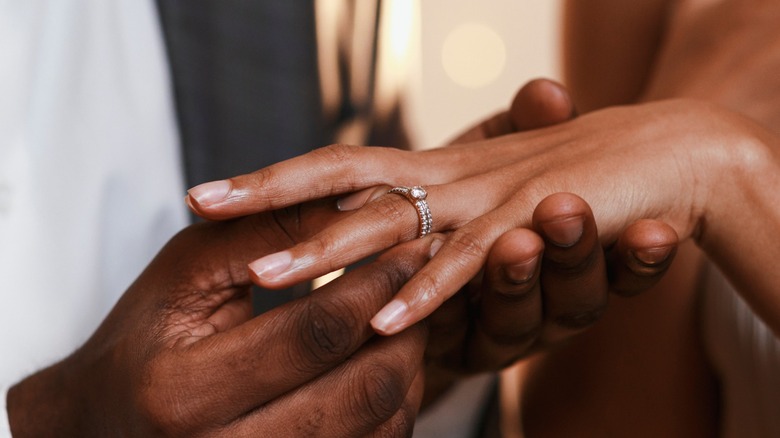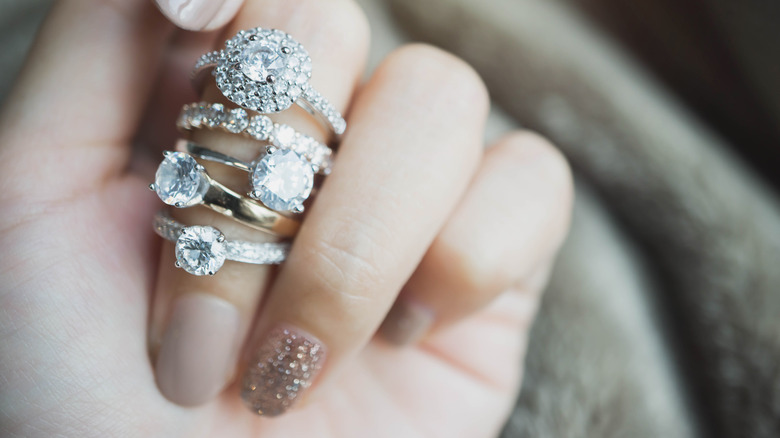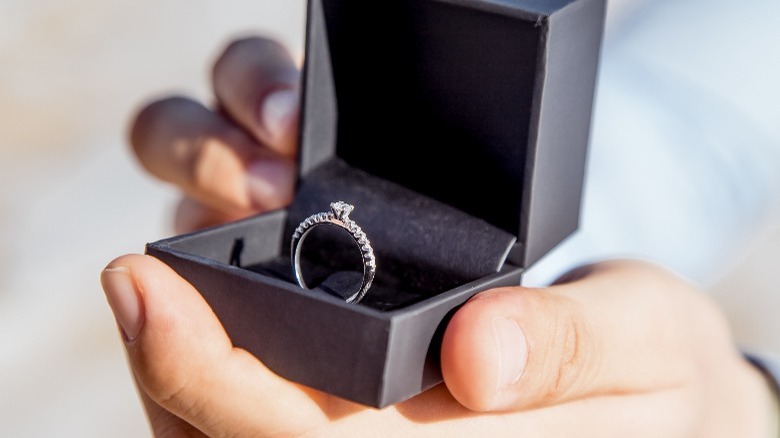The Simple Carat Hack That Can Save You Thousands On An Engagement Ring
Getting engaged is a romantic, special moment in your life. But once you start shopping for that engagement ring and seeing the price tags, that dreamy energy can turn a little nightmarish. If you're starting to think you'll need to drain your savings to get the perfect ring, take a breath: There is truly no correct amount to spend on an engagement ring. You can save money and get the ring you want with a simple jewelry shopping trick.
This may sound obvious, but the easiest way to save money on a diamond ring is to go for a smaller size stone. For some, this might mean getting a sweet, dainty diamond that's elegant and understated. However, if you have a bit more wiggle room in your budget, there's a way for you to still explore larger diamond sizes without hitting your spending limit. If you're trying to get your hands on a gorgeous rock without breaking the bank, it's time to discover the wonderful world of fractional sizes.
How to save money on an engagement ring
When trying to save money on a diamond engagement ring, fractions are your friend. Diamonds are valued by their size in carats, but the rates don't always go up proportionally. Prices are usually set by size range, rather than incremental increases with each fraction of a carat. So, while a 1.9-carat diamond and a 2-carat diamond have only a one-tenth difference in size, the 2-carat stone will be significantly more expensive than the 1.9, because 2-carat diamonds enter a new price range. The diamond industry calls these carat sizes "magic numbers," where the typical diamond price will rise, such as 1.5 to 2 carats versus 2 to 3 carats.
This concept has gotten a lot of attention recently due to a popular clip from Netflix's "Indian Matchmaking" going viral on TikTok. It shows a founder of the jewelry brand Sonu Company (@sonu.company) explaining, "Every time we hit that whole number, diamond prices jump exponentially." Per the jeweler's recommendation, anyone in the market for a diamond ring should subtract a couple tenths of a carat from their desired size to avoid spending unnecessary money.
Now, doesn't this mean you'll get a smaller stone than you want? Technically, yes, the diamond will be smaller, but a fractional difference in carat size isn't noticeable to the human eye, so it certainly won't detract from your enjoyment of your beautiful engagement ring.
Alternatives to large diamond engagement rings
The easiest alternative to an expensive diamond engagement ring is to get a smaller size stone. Sometimes this means going down a fraction of a carat, but if you need to reduce the size significantly, you'll have to get creative with the shape. You can reduce the overall surface area and weight of a diamond by getting a cut that has your desired shape on the top but is extremely thin on the sides. People rarely look that closely at the other sides of the diamond, and you will still have the same visual effect you'd get from a larger stone. Certain diamond shapes are known for being less expensive.
Aside from playing around with the size, another way to save money on an engagement ring is to explore alternative stones. You can switch a natural diamond out for a lab-grown diamond, which has all the same qualities of a diamond but comes with a smaller price tag. Other popular alternative stones include moissanite, opal, and aquamarine. Some folks may want to forgo gemstones altogether and choose a synthetic option, such as a cubic zirconia, instead.
No matter how you modify a traditional engagement ring to suit your lifestyle needs, whether it's decreasing a diamond's size or swapping it out for a less expensive gemstone, you can still find a beautiful ring that commemorates this special moment in your relationship.


